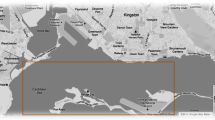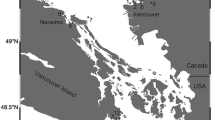Abstract
The transfer of chlorinated hydrocarbons (CHC) in a laboratory simulation of a three trophic level marine food chain was studied. The food chain consisted of the algal flagellate Dunaliella sp., the rotifer Brachionus plicatilis, and the larva of the Northern anchovy Engraulis mordax. CHC were introduced into the seawater at concentrations representative of near-shore conditions off southern California without the use of dispersing agents. Each trophic level appeared to be in a steady-state at the time of first sampling, 5 days after inoculation. Apparent partition coefficients were calculated for each trophic level. The CHC contamination in the diet of the rotifers and anchovy larvae was also calculated. Unfed anchovy larvae accumulated the same amount of CHC as fed larvae and the final concentration appeared to be dependent on the CHC concentration in the seawater. The data in this report suggest that CHC accumulation is not a food-chain phenomenon but rather the result of direct partitioning of the compounds between the seawater and the test organisms.
Similar content being viewed by others
Literature Cited
Addison, R.F., S.R. Kerr and J. Dale: Variation of organochlorine residue levels with age in Gulf of St. Lawrence harp seals (Pagophilus groenlandieus). J. Fish. Res. Bd Can. 30, 595–600 (1973)
Bidleman, T.F. and C.E. Olney: Chlorinated hydrocarbons in the Sargasso Sea atmosphere and surface water. Science, N.Y. 183, 516–518 (1974)
Butler, P.A.: The sub-lethal effects of pesticide pollution. In: Symposium on the Biological Impact of Pesticides in the Environment, pp 87–96. Ed. by J.W. Gillet. Corvallis, Oregon: Oregon State University 1970
Cox, J.L.: DDT residues in marine phytoplankton: increase from 1955–1969. Science, N.Y. 170, 71–73 (1970)
—: DDT redisues in sea water and particulate matter in the California Current system. Fish. Bull. U.S. 69, 443–450 (1971)
DeLong, R.L., W.G. Gilmartin and J.G. Simpson: Premature births in California sea lions: association with high organochlorine pollutant residue levels. Science, N.Y. 181, 1168–1169 (1973)
Grzenda, A.R., D.F. Paris and W.J. Taylor: The uptake, metabolism and elimination of chlorinated residues by goldfish (Carassius auratus) fed a 14C-DDT contaminated diet. Trans. Am. Fish. Soc. 99, 385–396 (1970)
Hamelink, J.L., R.C. Waybrant and R.C. Ball: A proposal: exchange equilibria control the degree chlorinated hydrocarbons are biologically magnified in lentic environments. Trans. Am. Fish. Soc. 100, 207–214 (1971)
Harvey, G.R., W.G. Steinhauer and J.M. Teal: Polychlorobiphenyls in North Atlantic Ocean water. Science, N.Y. 180, 643–644 (1973)
Hom, W., R.W. Risebrough, A. Soutar and D. Young: Deposition of DDE and polychlorinated biphenyls in dated sediments of the Santa Barbara basin. Science, N.Y. 184, 1197–1198 (1974)
Hunter, J.R.: Swimming and feeding behavior of larval anchovy Engraulis mordax. Fish. Bull. U.S. 70, 821–838 (1972)
Lasker, R., H.M. Feder, G.H. Theilacker and R.C. May: Feeding, growth, and survival of Engraulis mordax larvae reared in the laboratory. Mar. Biol. 5, 345–353 (1970)
Leong, R.: Induced spawning of the northern anchovy, Engraulis mordax, Girard. Fish. Bull. U.S. 69, 357–360 (1971)
Macek, K.J. and S. Korn: Significance of the food chain in DDT accumulation by fish. J. Fish. Res. Bd Can. 27, 1496–1498 (1970)
MacGregor, J.S.: Changes in the amount and proportions of DDT and its metabolites, DDE and DDD, in the marine environment off southern California, 1949–72. Fish. Bull. U.S. 72, 275–293 (1974)
MacGregor, J.S.: DDT and its metabolites in the sediments off southern California. Fish. Bull. U.S. (In press). (1976)
McClure, V.E.: Precisely deactivated adsorbents applied to the separation of chlorinated hydrocarbons. J. Chromat. 70, 168–170 (1972)
McClure, V.E.: Transport of heavy chlorinated hydrocarbons in the atmosphere. Envir. Sci. Technol. (In press). (1976)
McClure, V.E.: and J. LaGrange: Deposition of chlorinated hydrocarbons from the atmosphere. Bull. envir. Contam. Toxicol. (In press). (1976)
McClure, V.E., E.D. Scura, G.H. Theilacker and G.W. Rommel: Exchange of PCB between air and sea water and its dependence upon colloid association. (In preparation)
Yoore, N.W. and J. O'G. Tatton: Organochlorine insecticide residues in the eggs of sea birds. Nature, Lond. 207, 42–43 (1965)
Parsons, T.R., K. Stephens and J.D.H. Strickland: On the chemical composition of eleven species of marine phytoplankton. J. Fish. Res. Bd Can. 18, 1001–1016 (1961)
Pavlou, S.P., R.N. Dexter and J.R. Clayton, Jr.: Chlorinated hydrocarbons in coastal marine ecosystems. In: Proceedings of the International Conference on Transport of Persistent Chemicals in Aquatic Ecosystems, pp II-31–35. Ed. by Q.N. Lattam. Ottawa, Canada: National Research Council of Canada: 1974
Reinert, R.E.: Accumulation of dieldrin in an alga (Scenedesmus obliquus), Daphnia magna, and the guppy (Poecilia reticulata). J. Fish. Res. Bd Can. 29, 1413–1418 (1972)
Risebrough, R.W., D.B. Menzel, D.J. Martin and H.S. Olcott: DDT residues in Pacific sea birds: a persistent insecticide in marine food chains. Nature, Lond. 216, 589–590 (1967)
—, V. Vreeland, G.R. Harvey, H.P. Miklas and G.M. Carmigani: PCB residues in Atlantic zooplankton. Bull. envir. Contam. Toxicol. 8, 345–354 (1972)
Scura, E.D. and V.E. McClure: Chlorinated hydrocarbons in sea water: analytical method and levels in the northeastern Pacific. Mar. Chem. 3, 337–346 (1975)
Sims, G.G., C.E. Cosham, J.R. Campbell and M.C. Murray: DDT residues in cod livers from the maritime provinces of Canada. Bull. envir. Comtam. Toxicol. 14, 505–512 (1975)
Södergren, A.: Transport, distribution and degradation of chlorinated hydrocarbon residues in aquatic model ecosystems. Oikos 24, 30–41 (1973)
Stanley, R.L. and H.T. LeFavoure: Rapid digestion and cleanup of animal tissues for pesticide residue analysis. J. Ass. off. agric. Chem. 48, 666–667 (1965)
Theilacker, G.H. and M.F. McMaster: Mass culture of the rotifer Brachionus plicatilis and its evaluation as a food for larval anchovies. Mar. Biol. 10, 183–188 (1971)
Thomas, W.H.: An experimental evaluation of the C14 method for measuring phytoplankton production, using cultures of Dunaliella primolecta Butcher. Fishery Bull. Fish Wildl. Serv., U.S. 63, 273–292 (1964)
Wildish, D.J. and V. Zitko: Uptake of polychlorinated biphenyls from sea water by Gammrus oceanicus. Mar. Biol. 9, 213–218 (1971)
Woodwell, G.M., C.F. Wuster, Jr. and P.A. Isaacson: DDT residues in an east coast estuary: a case of biological concentration of a persistent insecticide. Science, N.Y. 156, 821–823 (1967)
Zitko, V.: Polychlorinated biphenyls and prganochlorine pesticides in some freshwater and marine fishes. Bull. envir. Contam. Toxicol. 6, 464–470 (1971)
Author information
Authors and Affiliations
Additional information
Communicated by J.S. Pearse, Santa Cruz
Rights and permissions
About this article
Cite this article
Scura, E.D., Theilacker, G.H. Transfer of the chlorinated hydrocarbon PCB in a laboratory marine food chain. Mar. Biol. 40, 317–325 (1977). https://doi.org/10.1007/BF00395724
Accepted:
Issue Date:
DOI: https://doi.org/10.1007/BF00395724




